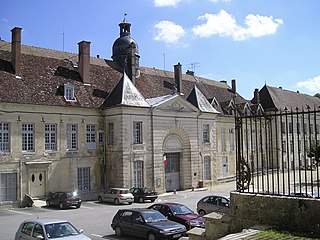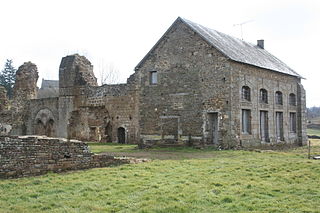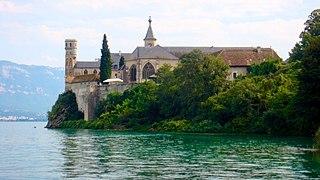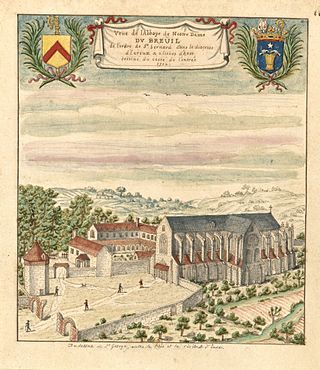
The Benedictines, officially the Order of Saint Benedict, are a monastic religious order of the Catholic Church following the Rule of Saint Benedict. They are also sometimes called the Black Monks, in reference to the colour of their religious habits. They were founded by Benedict of Nursia, a 6th-century monk who laid the foundations of Benedictine monasticism through the formulation of his Rule of Saint Benedict.

Clairvaux Abbey was a Cistercian monastery in Ville-sous-la-Ferté, 15 kilometres (9.3 mi) from Bar-sur-Aube. The original building, founded in 1115 by St. Bernard, is now in ruins; the present structure dates from 1708. Clairvaux Abbey was a good example of the general layout of a Cistercian monastery. The abbey has been listed since 1926 as a historical monument by the French Ministry of Culture.

The Tironensian Order or the Order of Tiron was a medieval monastic order named after the location of the mother abbey in the woods of Thiron-Gardais in Perche, some 35 miles west of Chartres in France). They were popularly called "Grey Monks" because of their grey robes, which their spiritual cousins, the monks of Savigny, also wore.

Robert of Molesme was an abbot, one of the founders of the Cistercian Order and is honored as a Christian saint.

Affligem Abbey is a Benedictine abbey in the municipality of Affligem, Flemish Brabant, Belgium, 19 km (12 mi) to the north-west of Brussels. Dedicated in 1086, it was the most important monastery in the Duchy of Brabant and therefore often called Primaria Brabantiae.

Vitalis of Savigny was the canonized founder of Savigny Abbey and the Congregation of Savigny (1112).

The monastic Congregation of Savigny started in the abbey of Savigny, situated in northern France, on the confines of Normandy and Brittany, in the Diocese of Coutances. It originated in 1105 when Vitalis of Mortain established a hermitage in the forest at Savigny in France.

Aulne Abbey was a Cistercian monastery located between Thuin and Landelies on the river Sambre in the Bishopric of Liège, Belgium. It is now a Walloon Heritage Site.

Hautecombe Abbey is a former Cistercian monastery, later a Benedictine monastery, in Saint-Pierre-de-Curtille in Savoie, France. For centuries it was the burial place of the members of the House of Savoy. It is visited by 150,000 tourists annually.

Jumièges Abbey was a Benedictine monastery, situated in the commune of Jumièges in the Seine-Maritime département, in Normandy, France.

The Abbey of Saint-Victor is a former abbey that was founded during the late Roman period in Marseille in the south of France, named after the local soldier saint and martyr, Victor of Marseilles.

Ligugé Abbey, formally called the Abbey of St. Martin of Ligugé, is a French Benedictine monastery in the Commune of Ligugé, located in the Department of Vienne. Dating to the 4th century, it is the site of one of the earliest monastic foundations in France. The original abbey having been destroyed during the French Revolution, the current monastic community dates from 1853, and belongs to the Solesmes Congregation.

Micy Abbey or the Abbey of Saint-Mesmin, Micy, sometimes referred to as Micy, was a Benedictine abbey near Orléans at the confluence of the Loire and the Loiret, located on the territory of the present commune of Saint-Pryvé-Saint-Mesmin. Since 1939 it has hosted a community of Carmelites

La Trappe Abbey, also known as La Grande Trappe, is a monastery in Soligny-la-Trappe, Orne, France. It is known for being the house of origin of the Trappists, to whom it gave its name.

The Abbey of Saint-Evroul or Saint-Evroul-sur-Ouche is a former Benedictine abbey in Normandy, located in the present commune of Saint-Evroult-Notre-Dame-du-Bois, Orne, Normandy. It has been classified as a historical monument since 1967. Its name refers to its founder, Ebrulf (Evroul), who founded a hermitage in the forest of Ouche around 560. The abbey was rebuilt around 1000.

The Abbaye Blanche was a nunnery founded in 1112 in Mortain, France.

Vaux-de-Cernay Abbey was a Cistercian monastery in northern France (Ile-de-France), situated in Cernay-la-Ville, in the Diocese of Versailles, Yvelines.

Molesme Abbey was a well-known Benedictine monastery in Molesme, in Laignes, Côte-d'Or, Burgundy, on the border of the Dioceses of Langres and Troyes.
Bernard of Thiron, also known as Bernard of Ponthieu and Bernard of Abbeville, was the founder of the Tiron Abbey and the Tironensian Order.

Le Breuil-Benoît Abbey is a former Cistercian abbey in Marcilly-sur-Eure in the Eure department of Normandy, France. It is located around 10 km to the west of Dreux, on the left bank of the river Eure.



















